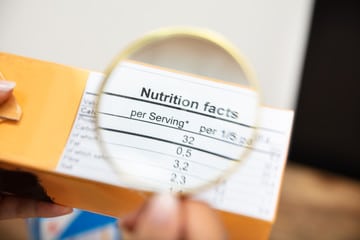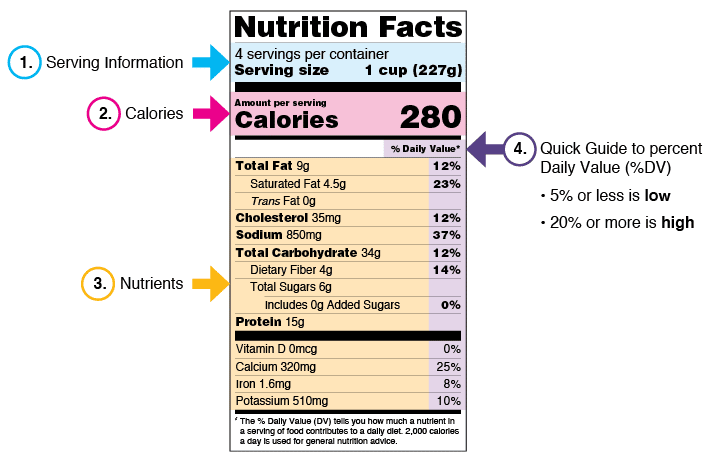Food and Nutrition Education Resources
Using Nutrition Facts Labels to Inform Your Food Choices
By: Jaz Popa, 12/19/2022

The nutrition facts label, on all food and beverages, is required by the US Food and Drug Administration (FDA). Reading the nutrition facts can help you learn more about what’s in your food, help monitor your intake of different nutrients, and help you learn what nutrients you might be getting too little or too much of. People read nutrition labels for many different reasons, but they can be wordy and confusing. Understanding nutrition facts can help you make quick and informed decisions about your food and help you choose the food that best fits your needs. However, please keep in mind that knowing what you’re consuming is important, but nutrition labels do not know what is best for you. Be sure to consult your doctor if you have particular health concerns and do not let the numbers on the label inhibit your ability to eat intuitively. Refer to the example of a nutrition facts label below as we learn what everything on the label means and how to read it.
1. Serving Information
The first thing to do when looking at the nutrition facts is to check the serving information at the top of the label. The serving size is not a recommended amount to consume and is not always equal to the entire package. The serving information will indicate how many servings are in the container. All the nutrient amounts shown on the label indicate the amounts for one serving, which is not always the entire package. This is why it is important to check the serving information first.
If we look at our example, one serving is 1 cup which is 280 calories, 6 grams of sugar, 15 grams of protein, etc. But what if you ate more than the listed serving size? If you ate two servings (2 cups), then you would have to multiply every nutrient amount by 2. So instead of 280 calories, you would have consumed 560 calories, 12 grams of sugar, etc.
2. Nutrients
Sections two and three on our example label indicate the nutrient section of the label. Some nutrients that you might want to consume more of include dietary fiber, Vitamin D, calcium, iron, and potassium. These are listed towards the bottom of the label. Saturated and trans fats, sodium, and added sugar are the nutrients you might want to get less of. The FDA states, “saturated fat, sodium, and added sugars are nutrients listed on the label that may be associated with adverse health effects – and Americans generally consume too much of them, according to the recommended limits for these nutrients.” If you have any dietary concerns regarding your nutrient intake and nutrients you should pay attention to, speak with a doctor.
3. Sugar
On all nutrition facts labels, you can find the amount of total sugar and added sugar, as now required by the FDA. Total sugars include the amount of sugar naturally present in the product as well as any added sugar. Added sugar indicates the amount of sugar that has been added during the processing of that product. This can include sugars from honey, syrup, fruit concentrates, table sugar, or artificial sweeteners. The word ‘includes’ before ‘added sugars’ on nutrition facts labels indicate that the added sugars listed are included in the number of ‘total sugars’ listed.
4. Percent Daily Value
The percent daily value (%DV) listed on the right-hand side of the label is the percentage of the daily value for each nutrient in one serving. This indicates the USDA recommended amount based on a 2,000- calorie diet. You may require a different caloric intake, so these percentages may not be accurate for you. However, you can still use them to see how a product fits into your daily meal plan. A simple, general rule you can follow is that 5% or less is low, and 20% or more is high. Try to aim for higher percentages of nutrients like vitamins, fiber, or potassium and aim for lower percentages of trans and saturated fats, sodium, and sugars.
5. Ingredients
Ingredient lists are listed separately from, and often underneath, the nutrition facts. Ingredients are listed in descending order by weight, meaning the first ingredient listed weighs the most and the ingredient listed last weighs the least.
Click below for an interactive nutrition label to learn more about using nutrition facts labels.
For more information about nutrition facts labels and how to read them, click the buttons below.

